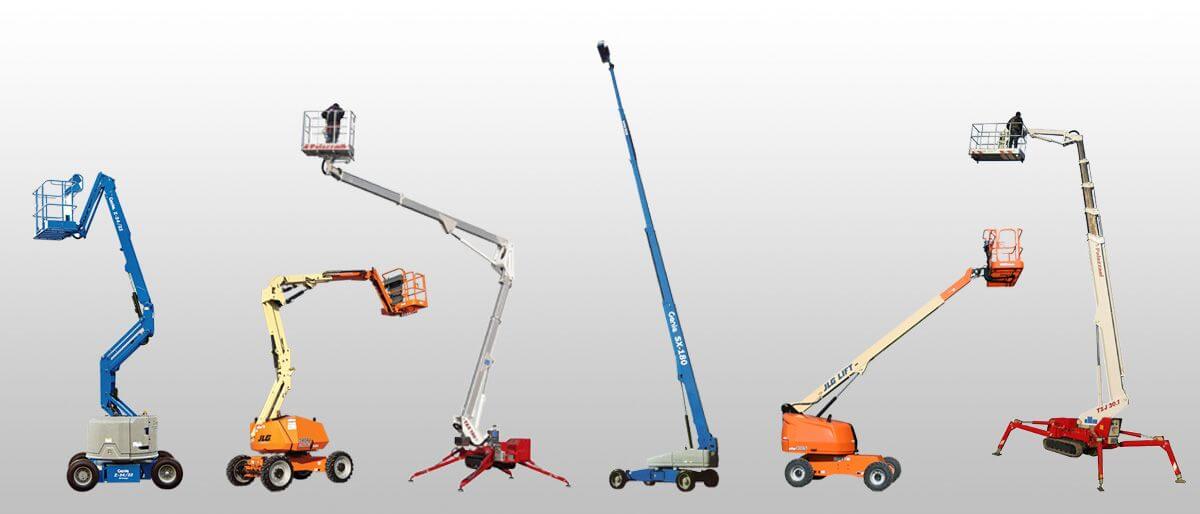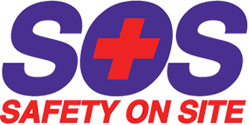An aerial lift is an aerial work platform equipment, also called an elevated work platform, used to complete tasks at an elevation much safer and more efficient. Aerial lifts (i.e. a boom lift or scissor lift) are commonly used on construction job sites, in the agricultural industry, for inspection purposes, athletic events, and repair services (i.e. hydro repair). Essentially, aerial lifts are used to lift workers to difficult elevated work positions.
These are many types of lifts and there are many names for these aerial lift machines. Some of these include electric scissor lifts, electric boom lifts, towable boom lifts, atrium lifts, rough terrain scissor lifts, straight telescopic boom lifts, cherry pickers, buckets trucks, articulated knuckle boom lifts and personnel lifts.
Which aerial lift do I need for my application?

This begs the question: what aerial lift do I need for my application? This decision can be very confusing and not having the right lift can cause a disastrous safety incident and cause the employer to lose time and money!!!
Understand the Lift Application and the Job Site!
The first thing is to keep in mind that one machine is not intended for every single application. It’s not a one size fits all situation. The different lifts are intended for different uses and applications.
Safety must be the employer’s top priority. Don’t force your operators to compromise safety and carefully select the right lift equipment with the right training for your employees. Every lift application is unique, so don’t make your choice based on previous situations, past rentals, equipment availability, convenience or best guess. The job itself will dictate which lift is required.
What to Consider with an Aerial Lift?
There are many factors to consider in your decision. You will need to consider the size, footprint and mobility of the equipment to ensure it fits safety standards. You will also need to consider how much space you have available to maneuver the machine in your workspace. You will need enough space to accommodate the machine, workers and the ability to maneuver both. Accurately measure the areas to ensure your workers and machine will fit appropriately. You will also need to consider how to get the lift from the delivery truck to the actual job site workspace. When you are thinking about size, also think about the extension range of the equipment. With size and reach, you will also want to understand the weight, movement type, capacity, job site conditions, space restrictions, and power source. Let’s look at these factors more closely.
1. Lift Capacity:
When researching lifts, there are two separate capacity ratings provided by lift manufacturers. The first rating is the maximum number of persons allowed in the aerial platform. The second rating is the total weight of the people, tools, and materials in the platform. Don’t exceed this rating as this will greatly increase the likelihood of an accident or potentially a fatality.
2. Space Restrictions:
Consider the space that your lift is moving through. Tall buildings with narrow doorways will require a different aerial lift than one used in a wide-open job site.
3. Weight Capacity:
To prevent overloading, you’ll want to account for how many workers (elbow room included) and gear that will be loaded on the aerial platform.
4. Lift Movement Types:
Aerial lifts can either be single-mast or multiple masts — in other words, its movement is either only vertical or both vertical and horizontal. The movement will determine the lift you need. Below are different types of lift movements.
- Scissor Lift: a vertical lift with a platform that’s the same size as the base.
- Boom Lift: a very versatile type of aerial lift. All varieties of these lifts have a base, a maneuverable arm and a work platform or attachment on the end of the arm.
- Telescopic Lift: an arm extends straight out and up and down
- Articulating Lift: an arm with a joint in their extension and provides more flexibility in its application
- Atrium Lift: a special type of articulated knuckle boom. This is a very narrow and lightweight lift ideal for achieving maximum elevation in a small area
- Personnel Lift: a very compact aerial lift that is usually used indoors. This lift is also called a man lift, one-man lift or push-around lift. This lift is used in tight workspaces. Personnel lifts can be from 2-3 feet wide and are rarely longer than 5 feet.
5) Lift Fuel Source to Consider:
Diesel powered lifts are quite popular due to availability and torque power; however, if working indoors, this would not be a safe fuel source option for this application. In this case you may want to consider an electric motor for its clean emissions and quieter operation. If your shifts are supporting a multi-shift operation you should consider a duel fuel liquid propane gas/diesel powered machine since there is no downtime required. Battery powered lifts typically run only 4 hours before they require recharging. When the battery is fully discharged, it will take from 6-8 hours before the battery is fully charged. In this case, dual fuel motors offer the most flexibility.
6) Job Site Terrain/Conditions:
Review your terrain and understand the lift manufacturer’s gradeability rating. This is found on the lift’s specification sheet. Questions to ask yourself:
- Does the terrain on the job site have a slope?
- What is the grade or slope?
- Is the ground rough, tricky to maneuver, soft, smooth?
- Is floor/ground capable of supporting the lift at its maximum capacity?
These conditions will determine the type of lift you will need. When looking at lifts and the workspace terrain, looking at the equipment’s wheels are equally important. There are many types of wheels to consider. For example, aerial lift wheels can be solid rubber, non-marking, flotation, standard pneumatic, and foam filled. Which wheels are best for the application?
7) Operator Training:
Once you have the right equipment, ensure you have the skills and competency required to safely operate your aerial lift. With an aerial platform certification, the aerial work operator (AWP) should learn to maintain full control of the equipment while complying with the regulations and laws governing its operation. With training, the operator will understand the legislated responsibilities and learn how to identify the components of the equipment and their functions. The operator will also know how to travel, and handle loads safely.
Aerial Lift Applications
Below are various types of aerial lifts and a brief summary of their application.
Electric Scissor Lifts
Best Application:
- Indoor use
- Small spaces
- Narrow areas like warehouses
- Multiple personnel
Height: From 10 feet – 60 feet
Workspace size: 2 feet to 10 feet wide
Rough Terrain Scissor Lifts
Best Application:
- Outdoor use
- Aerial work platform
- Multiple personnel
- Uneven surfaces. i.e. ungraded construction sites
Height: Up to 60 feet
Workspace size: 2 feet – 10 feet
Electric Boom Lifts
Best Application:
- Aerial work platform
- Confined spaces
- Workspaces where you’ll need to move from side to side
- Jobs that require multiple attachments
- Lifting one worker
Height: 30 feet over 100 feet, depending on equipment model
Workspace size: Equipment base ranges from 3 feet- 10 feet wide. Work platform varies more widely
Towable Boom Lifts
Best Application:
- Jobs where portability is important
- Outdoor decorating
Height: From 10 – 60 feet, depending on model
Workspace size: Usually 4 feet wide
Articulated Knuckle Booms
Best Application:
- Up-and-over workspaces
- Hard-to-reach areas like behind equipment
- Wide work areas that require extra reach
Height: Up to 125 feet
Width: Usually 3 to 8 feet wide
Straight Telescopic Boom Lifts
Best Application:
- Extremely high workspaces
- Workspaces with minimal horizontal movement
Height: Up to 185 feet
Workspace size: 8+ feet wide
Atrium Lifts
Best Application:
- Areas where weight capacity is a concern
- Extremely high reach
- Narrow workspaces
Height: Up to 60 feet
Workspace size: Approximately 3 feet wide; Lengths up to 20 feet
Personnel Lifts
Best Application:
- Indoor use
- Compact spaces
- Light construction
- Maintenance
Height: From 15 – 50 feet
Workspace size: 2 to 3 feet wide






